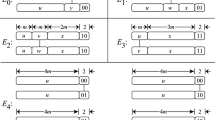Abstract
In the next decade, the high-performance supercomputers will consist of several millions of CPUs. The interconnection networks in such supercomputers play an important role for achieving high performance. In this paper, we introduce the Metacube (MC), a versatile family of interconnection network that can connect an extremely large number of nodes with a small number of links per node and keep the diameter rather low. An MC network has a 2-level hypercube structure. An MC(k,m) network can connect \(2^{2^{k}m+k}\) nodes with m+k links per node, where k is the dimension of the high-level hypercubes (classes) and m is the dimension of the low-level hypercubes (clusters). An MC is a symmetric network with short diameter, easy and efficient routing and broadcasting similar to that of the hypercube. However, the MC network can connect millions of nodes with up to 6 links per node. An MC(2,3) with 5 links per node has 16,384 nodes and an MC(3,3) with 6 links per node has 134,217,728 nodes. We describe the MC network’s structure, topological properties, routing and broadcasting algorithms, and the Hamiltonian cycle embedding in the Metacube networks.
Similar content being viewed by others
References
Adiga NR, Blumrich MA, Chen D, Coteus P, Gara A, Giampapa ME, Heidelberger P, Singh S, Steinmacher-Burow BD, Takken T, Tsao M, Vranas P (2005) Blue Gene/L torus interconnection network. IBM J Res Dev 49(2/3):265–276. http://www.research.ibm.com/journal/rd/492/tocpdf.html
Amawy AE, Latifi S (1991) Properties and performance of folded hypercubes. IEEE Trans Parallel Distrib Syst 2(1):31–42
Arabnia HR (1993) A transputer-based reconfigurable parallel system. Transput Res Appl (NATUG) 6:153–169
Bhandarkar SM, Arabnia HR (1995) The Hough transform on a reconfigurable multi-ring network. J Parallel Distrib Comput 24(1):107–114
Bhandarkar SM, Arabnia HR (1995) The refined multiprocessor theoretical properties and algorithms. Parallel Comput 21(11):1783–1806
Chang C, Lin C, Tan J, Huang H, Hsu L (2009) The super spanning connectivity and super spanning laceability of the enhanced hypercubes. J Supercomput 48(1):66–87
Efe K (1992) The crossed cube architecture for parallel computation. IEEE Trans Parallel Distrib Syst 3(5):513–524
Fu JS (2004) Hamiltonian-connectedness of the WK-recursive network. In: Proceedings of the 7th international symposium on parallel architectures, algorithms and networks (ISPAN’04), 2004, pp 569–574
Ghose K, Desai KR (1995) Hierarchical cubic networks. IEEE Trans Parallel Distrib Syst 6(4):427–435
Hayes JP, Mudge TN (1989) Hypercube supercomputers. Proc IEEE 17(12):1829–1841
Leighton FT (1992) Introduction to parallel algorithms and architectures: arrays, trees and hypercubes. Morgan Kaufmann, San Mateo
Li Y, Peng S, Chu W (2002) Hamiltonian cycle embedding for fault tolerance in dual-cube. In: Proceedings of the IASTED international conference on networks, parallel and distributed processing, and applications (NPDPA 2002), Tsukuba, Japan, October 2002, pp 1–6
Li Y, Peng S, Chu W (2004) Efficient collective communications in dual-cube. J Supercomput 28(1):71–90
Li Y, Peng S, Chu W (2008) Prefix computation and sorting in dual-cube. In: Proceedings of the 37th international conference on parallel processing (ICPP’08), Portland, Oregon, USA, Sept. 8–12, 2008, pp 389–396
Li Y, Peng S, Chu W (2008) An effective structure for algorithmic design and a parallel prefix algorithm on Metacube. In: Proceedings of the international conference on parallel and distributed computing, applications and technologies (PDCAT’08), Dunedin, New Zealand, Dec. 1–4, 2008, pp 54–61
Preparata FP, Vuillemin J (1981) The cube-connected cycles: a versatile network for parallel computation. Commun ACM 24:300–309
SGI (1997) Origin2000 Rackmount owner’s guide, 007-3456-003. http://techpubs.sgi.com/ 1997
TOP500 (2008) Supercomputer sites. http://top500.org/, Jun. 2008
Tucker LW, Robertson GG (1988) Architecture and applications of the connection machine. IEEE Comput 21:26–38
Vanvoorst B, Seidel S, Barscz E (1994) Workload of an ipsc/860. In: Proceedings of the scalable high-performance computing conference, 1994, pp 221–228
Wang D (2008) On embedding Hamiltonian cycles in crossed cubes. IEEE Trans Parallel Distrib Syst 19(3):334–346
Ziavras SG (1994) RH: a versatile family of reduced hypercube interconnection networks. IEEE Trans Parallel Distrib Syst 5(11):1210–1220
Author information
Authors and Affiliations
Corresponding author
Rights and permissions
About this article
Cite this article
Li, Y., Peng, S. & Chu, W. Metacube—a versatile family of interconnection networks for extremely large-scale supercomputers. J Supercomput 53, 329–351 (2010). https://doi.org/10.1007/s11227-009-0297-2
Received:
Accepted:
Published:
Issue Date:
DOI: https://doi.org/10.1007/s11227-009-0297-2




